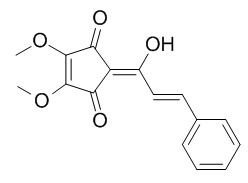Linderone
Linderone A shows anticancer activity against A549 non-small cell lung cancer cells and PC-3 prostate adenocarcinoma cell line.
Inquire / Order:
manager@chemfaces.com
Technical Inquiries:
service@chemfaces.com
Tel:
+86-27-84237783
Fax:
+86-27-84254680
Address:
1 Building, No. 83, CheCheng Rd., Wuhan Economic and Technological Development Zone, Wuhan, Hubei 430056, PRC
Providing storage is as stated on the product vial and the vial is kept tightly sealed, the product can be stored for up to
24 months(2-8C).
Wherever possible, you should prepare and use solutions on the same day. However, if you need to make up stock solutions in advance, we recommend that you store the solution as aliquots in tightly sealed vials at -20C. Generally, these will be useable for up to two weeks. Before use, and prior to opening the vial we recommend that you allow your product to equilibrate to room temperature for at least 1 hour.
Need more advice on solubility, usage and handling? Please email to: service@chemfaces.com
The packaging of the product may have turned upside down during transportation, resulting in the natural compounds adhering to the neck or cap of the vial. take the vial out of its packaging and gently shake to let the compounds fall to the bottom of the vial. for liquid products, centrifuge at 200-500 RPM to gather the liquid at the bottom of the vial. try to avoid loss or contamination during handling.
J Chem Inf Model.2021, 61(11):5708-5718.
Am J Chin Med.2015, 30:1-22
J Agric Food Chem.2024,72(37):20396-20409.
Cancer Manag Res.2019, 11:483-500
Int J Mol Sci.2024, 25(17):9673.
Biomolecules.2019, 9(11):E696
Appl. Sci.2024, 14(12), 5280.
J Chromatogr B Analyt Technol Biomed Life Sci. 2017, 1064:115-123
Oncol Rep.2021, 46(2):166.
Life (Basel).2023, 13(2):457.
Related and Featured Products
Comb Chem High Throughput Screen. 2013 Feb;16(2):160-6.
Flavonoids and linderone from Lindera oxyphylla and their bioactivities.[Pubmed:
23173924]
A new Linderone A, namely 2-cinnamoyl-3-hydroxy-4, 5-dimethoxycyclopenta-2, 4-dienone (5), together with three known flavonoids (1-3) and one Linderone (4), were isolated from the bark of Lindera oxyphylla.
METHODS AND RESULTS:
Extensive spectroscopic analysis including 1D and 2D-NMR spectra determined their sturctures. In addition, the antioxidant activity of all the compounds has been determined using 2, 2-diphenyl-1-picrylhydrazyl radical scavenging (DPPH), ferric reducing antioxidant power (FRAP) and ferrous ion chelating (FIC) methods. Compound 3 showed excellent DPPH scavenging activity with IC50% value of 8.5 ± 0.004% (μg/mL) which is comparable with vitamin C. This compound, also showed an absorbance value of 1.00 ± 0.06% through FRAP test when compared with Butyl Hydroxy Aniline (BHA). However, FIC showed low activity for all the isolated compounds (chelating activity less than 50%) in comparison with ethylene diamine tetra acetic acid (EDTA). Anticancer activity for all compounds has also been measured on A375 human melanoma, HT-29 colon adenocarcinoma, MCF-7 human breast adenocarcinoma cells, WRL-68 normal hepatic cells, A549 non-small cell lung cancer cells and PC-3 prostate adenocarcinoma cell line.
CONCLUSIONS:
Compound 1 showed A549=65.03%, PC-3=30.12%, MCF-7=47.67, compound 2 showed PC-3=90.13%, compound 3 showed MCF-7=79.57 and for compound 5 MCF-7 is 96.33.
Org Lett. 2010 May 21;12(10):2354-7.
Bi-linderone, a highly modified methyl-linderone dimer from Lindera aggregata with activity toward improvement of insulin sensitivity in vitro.[Pubmed:
20420414]
Bi-Linderone (1) was isolated as racemate from the traditional Chinese medicinal plant Lindera aggregata.
METHODS AND RESULTS:
The structure elucidation of bi-Linderone was reported on the basis of extensive analysis of NMR spectra and crystal X-ray diffraction. Bi-Linderone has an unprecedented spirocyclopentenedione-containing carbon skeleton and showed significant activity against glucosamine-induced insulin resistance in HepG2 cells at a concentration of 1 microg/mL.
Org Lett. 2011 May 6;13(9):2192-5.
Biomimetic total syntheses of linderaspirone A and bi-linderone and revisions of their biosynthetic pathways.[Pubmed:
21446662]
METHODS AND RESULTS:
Simple exposure to sunlight is sufficient for triggering photochemical [2 + 2] cycloaddition-Cope or radical rearrangement cascades in the naturally occurring methyl Linderone, leading to efficient biomimetic total syntheses of linderaspirone A and bi-Linderone, two recently discovered bioactive spirocyclopentenedione natural products.
Mini Rev Med Chem. 2014 Apr;14(4):322-31.
Chemical properties and biological activities of cyclopentenediones: a review.[Pubmed:
24605879]
METHODS AND RESULTS:
Cyclopentenediones (CPDs) are secondary metabolites of higher plants, fungi, algae, cyanobacteria and bacteria. A common denominator of CPDs is the cyclopent-4-ene-1,3-dione skeleton (1), which is modified by several functional groups. The heterogeneity of these substitutions is reflected in around one hundred CPDs reported to date. Most of the derivatives were isolated primarily from plant sources.
Synthetic analogues were then prepared with new biological activities and more interesting pharmacological potential.
CONCLUSIONS:
Antifungal substances called coruscanones (2, 3) are the most studied of the CPDs. Other intensely investigated CPDs include lucidone (4), Linderone (5), asterredione (6), involutone (7), nostotrebin 6 (8), TX-1123 (9), G2201-C (10), madindolines (11, 12) and many others.



